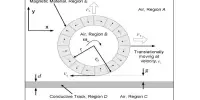Acoustic resonance occurs when an acoustic system amplifies sound waves with frequencies that match one of its own natural vibration frequencies (its resonance frequencies). It is a phenomena in which an object vibrates at its inherent frequency or a harmonic of that frequency in response to the application of an external force, such as sound waves. This phenomenon can cause an increase in the amplitude of vibrations, resulting in loud and clear sounds.
The phrase “acoustic resonance” is sometimes used to limit mechanical resonance to the frequency range of human hearing, however, because acoustics is defined in broad terms as vibrational vibrations in matter, acoustic resonance can occur at frequencies other than that of human hearing.
An acoustically resonant item typically contains multiple resonance frequencies, particularly harmonics of the strongest resonance. It will easily vibrate at some frequencies but less so at others. It will “pick out” its resonance frequency from a complicated excitation, such as an impulse or a wideband noise excitation. In essence, it filters out all frequencies other than its resonance.
Here’s a breakdown of the key components and characteristics of acoustic resonance:
- Natural Frequency: Every object has a natural frequency at which it tends to vibrate when disturbed. This frequency is determined by the object’s physical properties, such as its size, shape, and material composition.
- External Force: When an external force, typically in the form of sound waves, is applied to an object, it can cause the object to vibrate. If the frequency of the applied force matches the natural frequency of the object or one of its harmonics, resonance occurs.
- Amplification of Vibrations: When resonance occurs, the amplitude of the vibrations increases significantly. This amplification happens because the energy of the external force is absorbed and stored by the object, leading to sustained oscillations.
- Clear and Loud Sound: In musical instruments like guitars, violins, or wind instruments, acoustic resonance is desirable because it enhances the sound produced. The vibrations of the instrument’s body or air column are resonated, resulting in a clear and loud sound.
- Destructive Resonance: While resonance can produce desirable effects in some cases, it can also be detrimental. In structures such as bridges or buildings, if the frequency of external forces, like wind or seismic waves, matches the natural frequency of the structure, it can lead to destructive resonance, causing excessive vibrations and potential structural failure.
Applications
Acoustic resonance has many uses in engineering, music, and research. It is used in musical instrument design, acoustic engineering to improve sound quality in concert halls or auditoriums, and technologies such as ultrasound imaging and resonance frequency sensors.
Acoustic resonance is a significant concern for instrument builders because most acoustic instruments use resonators, such as violin strings and bodies, flute tube lengths, and drum membrane shapes.
Acoustic resonance is also essential for hearing. For example, resonance of a stiff structural part known as the basilar membrane within the cochlea of the inner ear enables hair cells on the membrane to detect sound. (In mammals, the membrane has tapering resonances along its length, so high frequencies are focused on one end and low frequencies on the other.
Understanding and managing acoustic resonance is critical in many industries, from generating beautiful music to preserving the structural integrity of buildings and bridges.
















